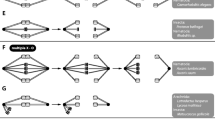Summary
-
1.
Mantis religiosa has a diploid chromosome number of 27 in males, there being 12 pairs of autosomes and an X1X2Y sex-determining trivalent at first meiosis.
-
2.
As in most other mantid species which have been studied cytologically, there is no diplotene stage in meiotic prophase. Pachytene is followed by a ‘prometaphase stretch’ stage, when persistent points of association between homologous chromosomes are revealed. Most bivalents remain associated in one arm only at metaphase, though bivalents with associations in both arms on either side of the centromere also occur.
-
3.
No failure of pairing is observable at pachytene, but cells with unassociated autosomes or sex-chromosomes can be seen at metaphase. Univalent sex-chromosomes are present three times as frequently as univalent autosomes, and X2 occurs as a univalent twice as often as X1. Cells containing univalents remain ‘blocked’ at metaphase and ultimately degenerate; this may explain the absence of supernumerary chromosomes in manticls, a notable distinction between these animals and. short-horned grasshoppers.
-
4.
Malorientation of the sex-trivalent occurs in less than 2% of first meiotic metaphases. It leads to non-disjunction of the sex-chromosomes and to peculiar and characteristic chromosome, bridges joining sister second spermatocytes.
-
5.
In spite of the absence of a diplotene stage, there are strong grounds for supposing that autosomes and sex-chromosomes are associated by chiasmata at first meiotic metaphase.
-
6.
It has been suggested by White that X1X2Y rnantid species have a monophyletic origin from a primitive XO species in which translocation took place between the original X-chromosome and one of a pair of autosomes. Whereas in other X1X2Y mantids the relative sizes and mode of association of the three sex-chromosomes indicate that considerable evolutionary change has taken place since the trivalent sex-determining mechanism was first established, there is evidence that inM. religiosa we are able to see the sex-chromosomes in their ancestral form and meiotic behaviour.
Similar content being viewed by others
References
Asana, J. J. (1934). Studies on the chromosomes of Indian Orthoptera. IV. The idiochromosomes ofHierodula sp.Curr. Sci. 2, 244.
Erazi, A. R. R. (1940). Contribution à 1’étude chromosomique des Mantidae européennes.Rev. Fac. Sci. Univ. Istanbul,5, 1.
Giardina, A. (1897). Primi stadi embrionali dellaMantis religiosa. Nota preventiva.Monit. zool. ital. 8, 275.
Hughes-Schrader, S. (1943a). Meiosis without chiasmata-in diploid and tetraploid spermatocytes of the mantidCallimantis antillarum Saussure.J. Morph. 73, 111.
Hughes-Schrader, S. (1943b). Polarization, kinetochore movements, and bivalent structure in the meiosis of male mantids.Biol. Bull., Woods Hole,85, 265.
Hughes-Schrader, S. (1948). Expulsion of the sex-chromosome from the spindle in spermatocytes of a mantid.Chromosoma,3, 257.
Hughes-Schrader, S. (1950). The chromosomes of mantids (Orthoptera: Manteidae) in relation to taxonomy.Chromosoma,4, 1.
Hughes-Schrader, S. (1953). Supplementary notes on the cyto-taxonomy of mantids (Orthoptera: Mantoidea).Chromosoma,6, 79.
Inamdar, N. B. (1949). A note on the reorientation within the spindle of the sex-trivalent in a mantid.Biol. Bull., Woods Hole,97, 300.
King, R. L. (1931). Chromosomes of three species of Mantidae.J. Morph. 52, 523.
Matthey, R. (1949). La formule chromosomique et la meiose chezApteromantis bolivari Werner (Mantidae-Amelinae).Arch. Klaus-Stift. VererbForsch.24, 114.
Newton, W. C. F. (1927). Chromosome studies inTulipa and some related genera.J. Linn. Soc. (Bot.),47, 336.
Oguma, K. (1921). The idiochromosomes of the mantis.J. Coll. Agric. Sapporo,10, 1.
Oguma, K. (1946). Karyotype and phylogeny of mantids.Kromosomo,1, 1.
Staiger, H. (1954). Der Chromosomendimorphismus beim ProsobranchierPurpura lapillus in Beziehung zur ökologie der Art.Chromosoma,6, 419.
Suomalainen, E. (1946). Die Chromosomenverhältnisse in der Spermatogenese einiger Blattarien.Ann. Acad. Sci.fenn. 4, 1.
White, M. J. D. (1938). A new and anomalous type of meiosis in a mantid,Callimantis antillarum Saussure.Proc. Roy. Soc. B,125, 516.
White, M. J. D. (1940). The origin and evolution of multiple sex-chromosome mechanisms.J. Genet. 40, 303.
White, M. J. D. (1941). The evolution of the sex-chromosomes. I. The XO and X1X2Y mechanisms in praying mantids.J. Genet. 42, 143.
White, M. J. D. (1948). The chromosomes of the parthenogenetic mantidBrunneria borealis.Evolution,2, 90.
Williams, E. C. (1938). Spermatogenesis of a mantid,Choeradodis rhombicollis (Latreille).Trans. Amer. Micr. Soc. 57, 387.
Author information
Authors and Affiliations
Rights and permissions
About this article
Cite this article
Callan, H.G., Jacobs, P.A. The meiotic process inmantis religiosa L. males. J Genet 55, 200–217 (1957). https://doi.org/10.1007/BF02981625
Received:
Issue Date:
DOI: https://doi.org/10.1007/BF02981625




